
Tritonia bollandi
Smith & Gosliner, 2003
Order: NUDIBRANCHIA
Suborder: DENDRONOTINA
Family: Tritoniidae
DISTRIBUTION
Known from Okinawa & Indonesia.
PHOTO
Upper & Lower Right: type material on its food, the gorgonian Verrucella aurantia, Seragaki Tombs, Okinawa. Photos: R. Bolland.
Lower Left: Lembeh Strait, Sulawesi, Indonesia. Depth: 7m, 21 November 2001. Length: 50mm. Photo by M. & C. Nishina
Previously known on the Forum as Tritoniid species 8 this species has just been described from Okinawa as Tritonia bollandi in honor of its collector, Robert Bolland. In Okinawa it is found exclusively on its food, the gorgonian Verrucella aurantia (Gray, 1869) [Family Ellisellidae].
The animal reaches 88 mm in length, and mature specimens from the type locality, Okinawa, are olive green in color, with lighter colored branchial plumes, nearly white rhinophores, and a thin white margin along the notal margin. The body appears granular due to the presence of small low tubercles on all parts of the body, except for the foot. The oral veil is slightly bilobed and bears 12 to 14 elongate digitiform processes, many of which are apically bifid. The notal margin extends along and slightly overhangs the sides of the body. From the notal margin are produced 9 to 14 pairs of arborescent branchial plumes, and the sheaths of the rhinophores, whose margins are undulate and flange-like. The rhinophore shafts are retractable, and are palmate in appearance, with a central clavus surrounded by a stepped series of pinnate processes. External genitalia are on the right side of the animal, behind the third anterior branchial plume. The anus and nephroproct are also on the right side, behind and just below the 4th branchial plume, close to the notal margin. The anterior foot margin is rounded. Tritonia bollandi has been observed to feed upon gorgonian octocorals of the family Ellisellidae (Gray, 1859), in particular Verrucella aurantia (Gray, 1869). This nudibranch is named after the collector. Indonesian specimens on the Forum show a slightly different coloration
Reference:
• Smith, V. G. & Gosliner, T. M. (2003) A new species of Tritonia from
Okinawa (Mollusca: Nudibranchia), and its association with a gorgonian octocoral. Proceedings of the California Academy of Sciences, 54 (16): 255-278, 16 figs.
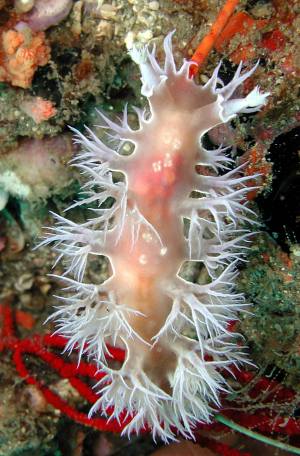
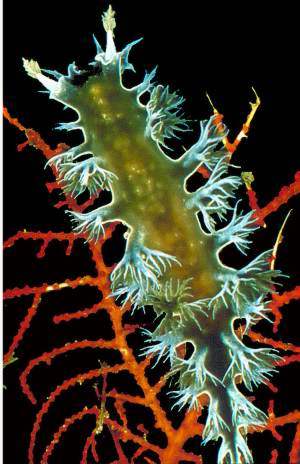
Smith, V. G., 2003 (August 16) Tritonia bollandi Smith & Gosliner, 2003. [In] Sea Slug Forum. Australian Museum, Sydney. Available from http://www.seaslugforum.net/find/tritboll
Related messages
Tritonia bollandi from Singapore
March 15, 2005
From: Lim Han Peng

Hi Bill,
I found this nudibranch at Pulau Hantu, Singapore. It was holding onto a whip coral. It is probably a Tritonia species.. But i'm not sure the exact scientific name of it..
Please advise.
Locality: Pulau Hantu, Singapore, South China Sea. Depth: 14 m. Length: 30 mm.12 March 2005. Photographer: H.P. Lim
H.P. Lim
limhp@hotpop.com

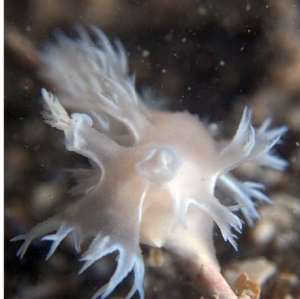
Dear HP,
This is the recently named Tritonia bollandi. It has previously only been found on the bright red gorgonian Verrucella aurantia (Fam: Ellisellidae). I'm not an expert on gorgonians and sea whips but certainly some members of the Ellisellidae are unbranched 'sea whips' so your observation that it was found on a sea whip is a valuable additon to our knowledge of the species.
Best wishes,
Bill Rudman
Tritonia bollandi from Indonesia
March 22, 2004
From: Alice Lee

Hi, Bill,
Is this a Tritonopsilla alba? I photo it in Batam [Batam Is, Riau Islands, Indonesia] during a night dive. There were 2 hanging on 1 whip coral.
Depth : 10m
Size 2 inches
Regards,
Alice
alice_leech@email.com
Lee, A., 2004 (Mar 22) Tritonia bollandi from Indonesia. [Message in] Sea Slug Forum. Australian Museum, Sydney. Available from http://www.seaslugforum.net/find/12283Dear Alice,
This is the recently named Tritonia bollandi. Wherever it is found it seems to be associated with a red gorgonian. In photos on the Forum from Okinawa and Indonesia it is on Verrucella aurantia but that species seems to have a more irregular shape than your gorgonian. Perhaps the gorgonian in your photo is just another growth form.
Tritonopsilla alba is now considered to be just a white form of Tritoniopsis elegans which feeds on the leathery soft coral Lobophyton.
Rudman, W.B., 2004 (Mar 22). Comment on Tritonia bollandi from Indonesia by Alice Lee. [Message in] Sea Slug Forum. Australian Museum, Sydney. Available from http://www.seaslugforum.net/find/12283Tritonia bollandi color variation
August 19, 2003
From: Bob Bolland

Hi Bill,
Re your asking about color variation of Tritonia bollandi in a recent Forum post:
I've collected a total of eight individuals, ranging in TL from 17mm to 88mm; collection depth for all 8 was between 185ft (56m) to 235ft (72m). All eight animals, with the exception of the 18mm animal, have a thin white margin along the notal margin . . . perhaps the pigment hasn't yet been lain down on the smaller animal(?). The majority of the specimens are very close in color to the Nishina Masayoshi animals depicted on the Forum. Two of the Okinawa animals are olive green in color while the remainder are very light colored.
I'm enclosing a photo of the 18mm animal.
Data: RFB #3600-A
TL: 18mm
210ft (64m)
Seragaki, Okinawa
22 Jun '97
Cheers,
Bob
bollandr@rapid-link.ne.jp
Bolland, R.F., 2003 (Aug 19) Tritonia bollandi color variation. [Message in] Sea Slug Forum. Australian Museum, Sydney. Available from http://www.seaslugforum.net/find/10771Thanks Bob,
Bill Rudman
Tritonia bollandi from Okinawa
August 16, 2003
From: Bob Bolland

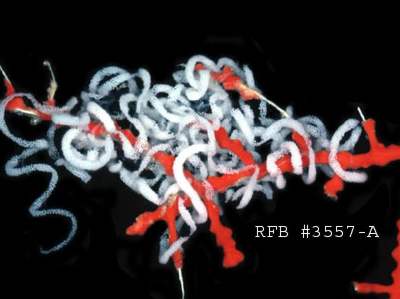
Hi Bill,
Here's an image of the recently described Tritonia bollandi from Okinawa. I've collected a half dozen of these and all would appear to be members of the same species. I've enclosed a second photo of the ova (?, the animal was not found on the eggs and my field notes only say the 'branch was found nearby on the same octocoral).
Data:
Collection #: RFB #3557-A
Location: Seragaki, Okinawa
Collection date: 1 March, 1997
TL: 16mm
Depth: 225ft (69m)
Cheers,
Bob
bollandr@rapid-link.ne.jp
Thanks Bob,
By coincidence, your message arrived at the same time as Vic's message letting me know that his description, with Terry Gosliner, of this as T. bollandi had been published. It is interesting how the colour of this animal is much more similar in colour to the Indonesian animals than the photos of your on which they based their description. Vic suggests the colour difference may be depth related. Can you give us any information on colour variation in Okinawan animals?
Best wishes,
Bill Rudman
Tritonia bollandi from Okinawa
August 16, 2003
From: Vic Smith

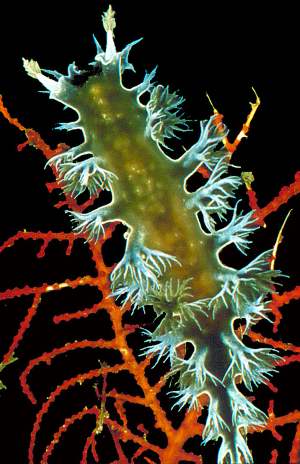
Dear Bill,
The animal shown as tritoniid species 8 on the Forum has just been described from Okinawa as Tritonia bollandi in honor of its collector, Robert Bolland. The photos from Indonesia on your message page show a slightly pinker color form than the Okinawan photos, but the animal is clearly the same. It is on its food source in your pictures, a gorgonian in the family Ellisellidae, and appears to be the same one our Okinawan specimens were feeding on, Verrucella aurantia (Gray, 1869). The complete description can be found in the July proceedings of the California Academy of Sciences.
Here is some information for the species Fact Sheet:
Tritonia bollandi Smith and Gosliner, 2003) is described from its type locality of Seragaki Tombs, Okinawa, and has been found at depths of 58 to 75 m. The animal reaches 88 mm in length, and mature specimens are olive green in color, with lighter colored branchial plumes, nearly white rhinophores, and a thin white margin along the notal margin. The body appears granular due to the presence of small low tubercles on all parts of the body, except for the foot. The oral veil is slightly bilobed and bears 12 to 14 elongate digitiform processes, many of which are apically bifid. The notal margin extends along and slightly overhangs the sides of the body. From the notal margin are produced 9 to 14 pairs of arborescent branchial plumes, and the sheaths of the rhinophores, whose margins are undulate and flange-like. The rhinophore shafts are retractable, and are palmate in appearance, with a central clavus surrounded by a stepped series of pinnate processes. External genitalia are on the right side of the animal, behind the third anterior branchial plume. The anus and nephroproct are also on the right side, behind and just below the 4th branchial plume, close to the notal margin. The anterior foot margin is rounded. Tritonia bollandi has been observed to feed upon gorgonian octocorals of the family Ellisellidae (Gray, 1859), in particular Verrucella aurantia (Gray, 1869). This nudibranch is named after the collector. The Indonesian specimens show a slightly different coloration, perhaps due to the depth they were living?
Thanks
Vic Smith
Ecology and systematics
California Academy of Sciences
vsmith@calacademy.org
Smith V.G., 2003 (Aug 16) Tritonia bollandi from Okinawa. [Message in] Sea Slug Forum. Australian Museum, Sydney. Available from http://www.seaslugforum.net/find/10740Dear Vic,
Thanks for the 'Fact Sheet'. It's a great help to get the information straight from the authors.
Best wishes,
Bill Rudman
Tritoniid sp. 8 from Indonesia
June 2, 2003
From: Nishina Masayoshi
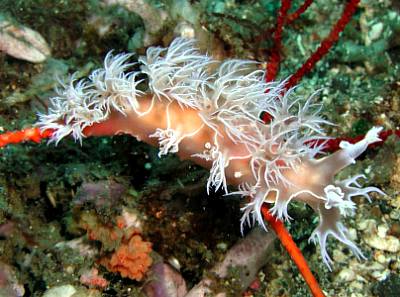
Dear Bill,
I photographed the attached image at Lembeh Strait too. It seems not to be rare there.
I found it in the shallow place with a depth of 7m. I suspect that the red soft coral this animal hangs on is their food?
Thanks to the transparent body surface of this animal, the heart or internal organs was observable. I could also see the genital orifice and anus. I ould also see some cream-colored tubercles in the skin but I can not imagine what they are.
Date: 21 Nov,2001
Loc: Lembeh Strait, Sulawesi, Indonesia.
Depth: 7m
Length: 50mm
Photo by M. & C. Nishina
I have a question about the name 'Tritoniid sp. 8' you have given to this animal on the Forum. I would have called it Tritonnidae sp. I have tried to search the meaning of the "Tritoniid", but I could not find it. Would you explain the difference when you say "Tritoniidae" and "Tritoniid".
Best Regards,
Nishina Masayoshi
http://umiushi.zive.net/
nishina@wips.co.jp



This species has now been named Tritonia bollandi. - Note added 16 Aug 2003
Thanks Nishina,
I have labelled the main openings in the closeup alongside. The small pore alongside the anus is the kidney opening. I am not sure what the creamy spots - usually grouped in 4 - that can be seen through the skin. It is possible they are some parasite.
Concerning the meaning of 'Tritoniid'. It is just a descriptive word for members of the family Tritoniidae, just as I use 'chromodorid' to describe members of the Chromodorididae.
Best wishes,
Bill Rudman
Tritoniid sp. 8 from Indonesia
May 21, 2003
From: Jerry Pucelik
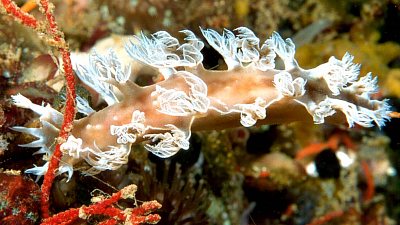
Hello,
Is this a photo of Tritoniid sp. 8.
I took the photo at 20 meters in Lembeh Strait, Indonesia, just down from Nudi Falls in August, 2002 in a patch where the Rhinopias hang out.
Thank you for your help.
Jerry Pucelik
jpucelik@prodigy.netT
Pucelik, J., 2003 (May 21) Tritoniid sp. 8 from Indonesia. [Message in] Sea Slug Forum. Australian Museum, Sydney. Available from http://www.seaslugforum.net/find/9636This species has now been named Tritonia bollandi. - Note added 16 Aug 2003
Dear Jerry,
Yes this is what I am calling Tritoniid sp. 8.
Best wishes,
Bill Rudman
Tritoniopsis? from Indonesia
February 12, 2003
From: Pat. Danna

Dear Bill,
It looks very much like the Tritoniopsis elegans in Neville Colman's book [1001 Nudibranchs], but less like this species as shown on Sea Slug Forum.
Lembeh Strait, Sulawesi, Indonesia. Depth 20m. Length: 5 to 6cm. November 2001. [#c29]
Thanks.
Pat. Danna
tdmpat@chez.com
Danna, P., 2003 (Feb 12) Tritoniopsis? from Indonesia. [Message in] Sea Slug Forum. Australian Museum, Sydney. Available from http://www.seaslugforum.net/find/9140This species has now been named Tritonia bollandi. - Note added 16 Aug 2003
Dear Pat,
It has some similarities to the white form of Tritoniopsis elegans but in that species the gill braches are proportionally smaller and more delicate, as are the papillae on the oral veil. We still have a way to go sorting out the Indo-West Pacific tritoniids so at present I will call your animal Tritoniid sp. 8.
Best wishes,
Bill Rudman
